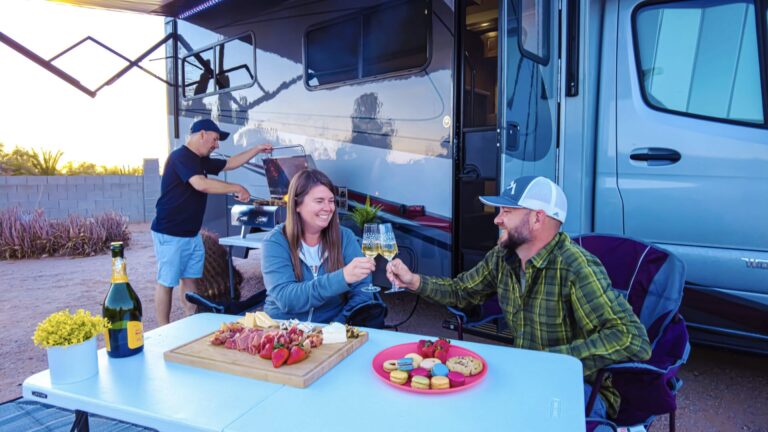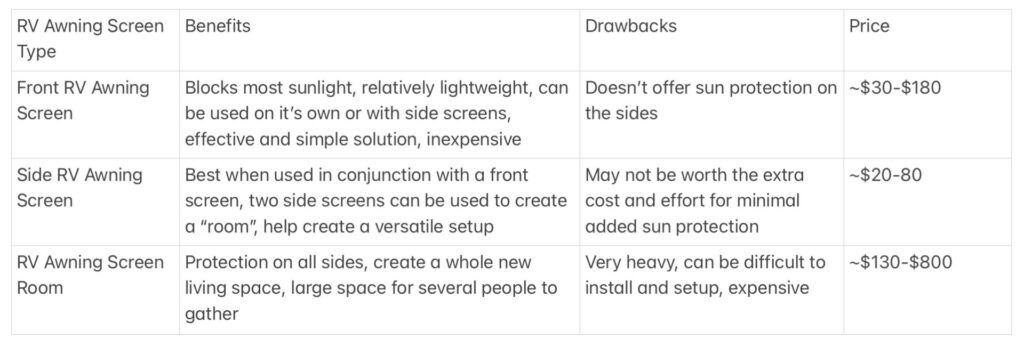
If you’re not familiar with RV awning screen rooms, then you’re in for a treat. These versatile rooms are perfect for increasing the usable size of your RV, plus they’re great for allowing you and your family to enjoy the great outdoors without being exposed to harsh weather conditions.
RVs are generally roomy vehicles that allow for plenty of living space — especially compared to a car or van — but things can feel confined after some time. Purchasing a screen room allows you to create a great deal of extra living space, but there are several things to consider before running out and buying your RV awning screen room.
This post contains affiliate links. RVshare may receive compensation if you make a purchase after clicking on a product link.
How Does an RV Awning Screen Room Work?
RV awning screen rooms work by attaching to your RV’s existing awning and creating an enclosed area off the side of your camper. This insulates the space against bugs, inhospitable heat, and rain to make the space more livable. They are also sometimes called awning rooms, or extend-a-rooms.
Setting Up an RV Awning Screen Room
When it comes to setting up your RV awning screen room, your product should come with installation instructions. If in doubt, there are also plenty of tutorials online (especially on YouTube) that you can benefit from.
Depending on your model, you may require a ladder for set-up. Some products also require you to permanently attach some fasteners to your awning or to temporarily hammer stakes into the ground to hold the room down.
This is a good example of an awning screen room installation:
Many RV owners who take advantage of an awning screen room believe that the initial set-up can be difficult but is well worth it. As you use your screen room more frequently, the set-up becomes a process that you become more familiar with.
The Finishing Touches
Once you have your RV awning screen room setup, make sure to add some finishing touches to make it feel like home. Have fun with this part!
You might choose to add any of the following:
Outdoor Mat
Putting down an outdoor mat will help keep the inside of your RV free of dirt and mud. It’ll also make it possible to walk comfortably barefoot in your RV screen room.
Fun Lighting
Whether you choose fairy lights, string lights, rope lights, or paper lanterns, adding some fun lightin to your RV awning screen room will help make it a more inviting place to be. It’ll also make it possible to use the room even after the sun goes down.
Comfy Seating
Nobody wants to sit on the ground. Get some comfy outdoor seating and a table or two for your screen room. This will make it a more welcoming place to sit and chat with friends, have a meal, listen to (or play) music, or watch a movie.
A Projector Screen
Speaking of watching movies, we highly recommend setting up a projector screen in your screen room. Doing so will give you the option to have outdoor movie nights without worrying about being attacked by bugs.
A Cooler
Want to have easy access to cold drinks while in your screen room? A cooler or even a mini fridge set in the screen room makes this possible and is a great addition to your outdoor living space.
A Space Heater or Fan
Putting a space heater in your RV awning screen room will make it a super cozy place to be in winter and adding a fan will help keep things comfortable during the hot winter months. Just know that you will need to be pretty close to that heater to feel its effects since the screen room is not enclosed.
RV Screen Room Pros and Cons
Screen Room Pros
Why do you need to buy an RV awning screen room? Do you really need one? There are more than a few advantages to owning one of these, but they might not be worth it for every RV owner.
- The screen-like material allows ventilation whilst keeping out insects.
- The space could potentially be used for grilling or other types of cooking, as it’s more well-ventilated than an indoor kitchen and may be easier to clean.
- It can increase your living area dramatically.
- It adds a layer of privacy if you’re in an RV park or another public area where you’d prefer not to feel as exposed to prying eyes.
- It offers some basic weather protection, so you don’t get any direct sunlight or rainfall while you’re sitting outside; a good screen will withstand wind quite well too.
Screen Room Cons
There are a few disadvantages, so let’s get out with them so you know.
- The screen room might not have as much air circulation as you’d like, trapping humidity and making cooking difficult when the smoke has nowhere to go.
- The set-up can prove difficult, particularly upon your first purchase. Most RVers get used to attaching and detaching their RV screen rooms for awnings so it goes by quicker after some practice, but that all depends on the specific person and model.
- They can be somewhat pricey. RV awning screens start at around $200 new, but some models will cost a pretty penny depending on the features. Make sure to ask yourself this before making your purchase— will I get enough use out of a screen room on my RV to justify spending the money?
The Difference Between an RV Awning Screen and a Screen Room
When searching for a screen room for your RV, you may also come across a lot of RV awning screens (also known as an RV awning sun screen). The most notable difference here is that an awning screen room can be enclosed on all sides, turning the space into what resembles a room. An awning screen, on the other hand, has just one sheet of screen which comes off the front of your awning, aiming to provide protection from the sun and add some privacy. The sides, however, are completely open to the elements.
Comparing RV Awning Screens
The table below will help you get an idea of the kinds of RV awning screens available, so you can determine which type is right for you.

Choosing the Right RV Awning Screen Room
Price
The price also depends heavily on the durability and quality of the screen room. Those priced closer to $500 generally offer more insulation and adaptability. These RV awning screens may have zippered compartments to let air in or trap it outside, or zippers that let you detach walls to have even more openness. This adaptability will make the screen room more suited to a wider range of temperatures so you can use it in hotter or cooler temperatures comfortably.
Size
The most important consideration, however, is in size. Measure the length and “drop” (distance from the top of the awning to the ground) of your awning to know the dimensions you’ll need. There should be an RV awning screen shade that corresponds to your specific needs in online stores or at a local retailer.
Features
Other distinctions between screen rooms include the color of the design and the quality of the support beams and tension mechanisms that hold the room in place — you want something that will hold up to the wind, if the need arises. There are also other kinds of screen shades on the market that offer different features. Without going into too much detail, you might look at something like this cabana dome.
Where Can You Buy RV Awning Screen Rooms?
If you’re ready to invest in an RV awning screen room, then you’ve come to the right place! You can purchase one through an online retailer (such as Camping World, Dometic, or ShadePro) and can often find a great deal on sites such as Amazon. Alternatively, you can do a quick Google search to find companies in your local area that specialize in this product.
So there you have it – our guide to RV awning screen rooms! Are you considering a screen for your RV awning? We hope that this information will now help you to make the best decision.






